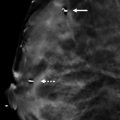Presentation and Presenting Images
( ▶ Fig. 72.1, ▶ Fig. 72.2, ▶ Fig. 72.3, ▶ Fig. 72.4)
A 45-year-old female presents for routine screening mammography.
72.2 Key Images
72.2.1 Breast Tissue Density
There are scattered areas of fibroglandular density.
72.2.2 Imaging Findings
The imaging of the right breast is normal (not shown). The left breast demonstrates a focal asymmetry (circle in ▶ Fig. 72.5 and ▶ Fig. 72.6) measuring 2 cm located at 12 o’clock, 9 cm from the nipple.
72.3 BI-RADS Classification and Action
Category 0: Incomplete. Need additional imaging evaluation and/or prior mammograms for comparison.
72.4 Diagnostic Images
72.4.1 Imaging Findings
Additional clinical information revealed that the patient has lost 150 pounds. Additional evaluation was performed for the focal asymmetry in the left breast at the 12 o’clock position. This finding is less prominent ( ▶ Fig. 72.7 and ▶ Fig. 72.8) than on the screening mammogram. In light of the patient’s weight loss since the comparison mammogram, this finding is most consistent with an island of breast parenchyma. Sonography is recommended to confirm benignity. Normal breast parenchyma is seen on ultrasound (not shown). The triangular marker on the left diagnostic images denotes a palpable asymmetry felt by the patient ( ▶ Fig. 72.7 and ▶ Fig. 72.8). No abnormality is seen on the digital breast tomosynthesis (DBT) images. Normal breast parenchyma is seen on ultrasound (not shown).
72.5 BI-RADS Classification and Action
Category 3: Probably benign
72.6 Differential Diagnosis
Normal breast tissue: Additional imaging showed the finding to be less conspicuous than on the screening mammogram.
Breast cancer: This asymmetry has a small likelihood of malignancy and is not likely breast cancer.
Fibrocystic changes: Fibrocystic changes may present as a focal asymmetry; however, the fact that there is no sonographic correlate makes this an unlikely possibility.
72.7 Essential Facts
In this case there were no additional findings at diagnostic mammography and no sonographic correlate so the likelihood of malignancy for this focal asymmetry is greater than 0% and less than 2%.
There are four types of asymmetries described in ACR BI-RADS Atlas, 5th edition : asymmetry, focal asymmetry, developing asymmetry, and global asymmetry.
An asymmetry is a finding seen on only one mammographic view.
A focal asymmetry is a nonmass lesion visible on at least two mammographic views that occupies less than a quadrant.
A developing asymmetry is a focal asymmetry that is new, larger, or more conspicuous than noted previously. The risk of malignancy is 15% at screening mammography and 25% at diagnostic mammography, making this a suspicious finding.
A global asymmetry is a nonmass lesion visible on at least two mammographic views and occupies at least a quadrant.
72.8 Management and Digital Breast Tomosynthesis Principles
The ability of DBT to eliminate the obscuration of overlapping breast tissue demonstrates no associated suspicious findings, further supporting the benignity of the this finding.
If DBT had identified associated or adjacent suspicious findings and these findings were not visible sonographically, biopsy could be performed using tomosynthesis-directed stereotactic biopsy.
72.9 Further Reading
[1] Leung JWT, Sickles EA. Developing asymmetry identified on mammography: correlation with imaging outcome and pathologic findings. AJR Am J Roentgenol. 2007; 188(3): 667‐675 PubMed
[2] Sickles EA, D’Orsi CJ, Bassett LW, et al. ACR BI-RADS Mammography. In: ACR BI-RADS Atlas, 5th edition. Reston, VA: American College of Radiology; 2013.

Fig. 72.1 Left craniocaudal (LCC) mammogram.
Stay updated, free articles. Join our Telegram channel

Full access? Get Clinical Tree








